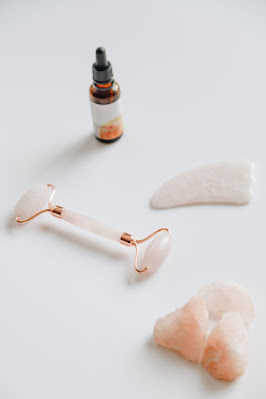My 7-Step Skin Care Routine
 |
| Photo by Viva Luna Studios on Unsplash |
Taking care of our skin is a lot more complicated than I previously thought. I learned that the things that we apply on our skin can do great wonders on its health. We need to be proactive in taking care of our skin which goes beyond simply washing it with water and soap. In fact, it might be more detrimental to use bar soaps or any kind of soap that would irritate the skin. But anyway, there are a few things that we need to do to take care of our skin. So, here's my 7-step skin care routine:
Core: Cleanse - Exfoliate - Moisturize
There are three parts that are essential to taking care of your skin. If you have searched online, you might have seen varying versions of people's skin care routine. Others would have fewer steps, while some will have more. Generally, you can have a minimum of three steps. These are cleansing, exfoliating, and moisturizing. The purpose of each is simple and pretty self-explanatory. You cleanse your face to get rid of the dirt and all other foreign particles that get stuck on it. Exfoliation helps to get rid of dead skin cells. And finally, you moisturize to keep your skin healthy, young-looking, and vibrant.
We can add other steps to this core three-step routine, but you can't have a decent skin care routine without these three. So, to expand on my 7-step skin care routine, I'll take you through each step from the beginning until the end.
1. Oil cleanser
The first step is to use oil cleanser to get rid of dirt, dust, and other particles that get stuck on the pores of your skin. The oil cleanser makes it slippery so that those particles will be easier to remove. There are some really good oil cleansers that I have used which I listed down in this article titled "5 Skincare Products to Solve Your Acne Problems".
2. Foam cleanser
As I said before, it's better not to use soaps that would irritate or sensitize your skin. That will just make your skin condition worse, and make it prone to having acne or pimples. So, it's best to just use a non-comedogenic and fragrance-free product. Usually, these types of products don't even produce as much suds or bubbles because they don't have sodium lauryl sulfate as an ingredient. Don't worry because they do wonders for your skin. Check this article again for some tips on great foam cleansers.
3. Exfoliant
After you cleanse with an oil cleanser and a foam cleanser, the next step is to exfoliate. And there are some great exfoliants out there, but I personally prefer Paula's Choice's BHA and AHA exfoliants. One is a liquid form which has salicylic acid, great to fight against blackheads and whiteheads. While the latter is in gel form and contains glycolic acid, which helps in making your skin look firm and smooth. Either one is good to use, but I would suggest getting the BHA exfoliant as it includes the wonderful salicylic acid as an ingredient. If your skin is acne-prone, that's the best product to use.
4. Niacinamide / Hyaluronic Acid
Ever since I started using products with niacinamide formulation, my skin's appearance has dramatically improved, so I'm a big proponent of niacinamide. It makes your skin look taut and also provides hydration. Generally, it's a great ingredient for any skin care product, and you can find various brands with niacinamide serums or formulas.
Hyaluronic acid is another great ingredient which you can use as an alternative to niacinamide. It doesn't have all the benefits that niacinamide has, but it can achieve similar effects as niacinamide as it also provides hydration, and makes your skin look young and healthy. You can probably use both at the same time if you have the budget for it, but honestly, either one is enough.
5. Retinol / Ascorbic Acid
So, these are basically Vitamin A and Vitamin C for your skin. They have the benefit of helping your skin fight off acne and brightens up your complexion as well. Retinol's cousin tretinoin is more potent than retinol, however, it also has a higher likelihood of causing skin irritation, so it's better to use retinol instead, because it's a milder version.
6. Moisturizer
Despite all the previous products containing ingredients with emollient properties, or properties that improves your skin's hydration, the concentration of those ingredients aren't in big doses, so that's not really their primary purpose. Instead, you need to have a product whose primary purpose is to hydrate and moisturize your skin. I have been using Cetaphil's moisturizer for as long as I can remember but there are other brands with their own moisturizers as well. Taking a shower does not moisturize skin as effectively as applying products with a concentration of skin-hydrating ingredients. Direct topical application of these ingredients will provide more effective results.
7. Sunscreen
This is more of an optional step, that is, only if you're going out of the house and be exposed to UV will you need to apply sunscreen. But, it's highly important to apply sunscreen especially if you are putting on an exfoliant because it would make your skin incredibly photosensitive or prone to sunburn. I have found that Beauty of Joseon's rice + probiotic sunscreen is the best out there.
So that's my 7-step skin care routine. Again, you don't have to do the same routine, as long as you're able to do the three core steps of cleansing, exfoliating, and moisturizing. Just with those three, your skin have the bare minimum of skin care.
Comments
Post a Comment